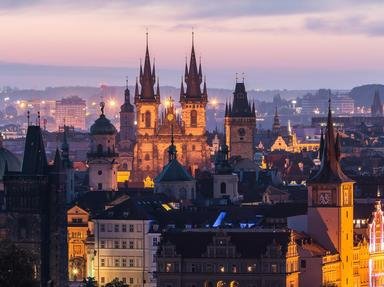Quiz Answer Key and Fun Facts
1. After Prague, this is the largest castle in the Czech Republic. It is a huge complex that includes three Renaissance courtyards, a graceful tower, an 18th-century theatre, extensive gardens, and even a bear pit. A highlight is the baroque ballroom where the walls are covered with frescos of masked dancers. Where is it?
2. The history of the great castle at Opocno has been affected by the strange and violent history of the Czech Lands. In 1805 a conference of three states was held here to plan Napoleon's defeat at Austerlitz. Things didn't exactly go as planned. What three countries represented the Triple Alliance?
3. From 1805 to 1824 Jan Rudolf Chotek built a superb, neo-classical residence at Kacina, just outside Kutna Hora. In the inscription over the sweeping white collonades, he dedicated the building to 'his family and descendants'. Unfortunately, the fortunes of this noble Czech family did not prosper in the 19th century and its most famous member died violently with her husband at Sarjevo in 1914. What was her name?
4. A small(ish) Renaissance manor is set just off the square of the pretty hill town of Nove Mesto nad Metuji. The building is picturesque and the gardens are lovely, but the big draw are the interiors. What style do they exemplify?
5. In the middle of the Czech Paradise, a protected area in East Bohemia, two great basalt horns loom over a plain. They are topped by two ruined towers, the last of what was once the impregnable medieval fortress of Trosky. The towers have names. What are they?
6. This great medieval fortress is considered one of the best-preserved castles in the Czech Republic. Just before the Thirty Years War a fire ripped through the building. As they had more pressing problems to attend to, the owners never got around to making many later improvements. It's name means 'bone' in Czech. What is it?
7. In the late 1600s a large-visioned count built an elaborate spa in the foothills of the Krkonose mountains that he thought would rival Carlsbad (Karlovy Vary). Four years after his death a flash flood washed away many of the buildings and the racecourse. Today only the great infirmary remains, a huge, haunted terrace lined with statues, and a sweeping stone staircase leading nowhere. Where is this?
8. Castolovice is an extremely lovely manor on the Knezna river. It is not only beautiful to look at, but as the residence of the brilliant Sternberk family, it has hosted many Czech intellectuals over the centuries. During the 1600s, a Jesuit priest lived here for a couple of years. He is famous for his book 'A Defense of the Slavonic Language Called Czech'. Who was he?
9. Konopiste is a gothic castle in Central Bohemia that today overwhelmingly bears the mark of the extensive neogothic renovations done in the 1890s. The interiors are all dark wood and hunting trophies, as the most notable former owner was an obsessive hunter, it seems. He was the husband of the Chotek Grand Duchess of Kacina and he died at Sarajevo too. Konopiste was their home for many years. Who was he?
10. On the outside it's a little pink Renaissance-Baroque jewel box of a building, set in the middle of a small lake. On the inside the furnishings and style are Empire. The semi-famous German composer Karl Ditters von Dittersdorf lived here during the 18th century. The name of the place means 'Red Hamlet'. Where are we?
Source: Author
dobrov
This quiz was reviewed by our editing team before going online.
Any errors found in FunTrivia content are routinely corrected through our feedback system.
